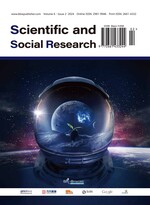Exploration of the Impact of Dynamic Narrative Approach on Public Exhibition Experience
Abstract
In today’s exhibition field, the dynamism of the narrative approach as a mainstream trend has permeated various aspects such as visual design, exhibit display, and media communication. On one hand, this is due to the development of digital media technology providing practical operational pathways; on the other hand, it is also a result of the information explosion brought about by the maturity of digital media technology, forcing exhibitions, as an important form of public cultural service, to stimulate public interest to the fullest extent in competition with other cultural products. In such a coincidental yet inevitable combination, how to effectively utilize a dynamic narrative approach within the exhibition field to provide the public with a sense of unfamiliarity in dimensions, boundaries, and situations, thereby constructing a unique perspective that enables people to perceive alienation relationships and ultimately resist the control of the technological landscape on humanity, becomes the key issue determining whether the integration between the two can be beneficial.
References
Ye H, Li D, Guo W, Exploring the Development Trends and Pathways of Exhibition Visual Design in the Digital Media Era. Art Research, 2021(4): 74–76.
Jie L, From “Container,” “Place” to “Society”: The Modern Turn of Spatial Narratives in Western Philosophy. Journal of Shenzhen University (Humanities and Social Sciences), 40(5): 144–152.
Kant I, 1999, Critique of Pure Reason (The Cambridge Edition of the Works of Immanuel Kant). Cambridge University Press, Cambridge.
Brecht B, 1992, Brecht on Theater. China Drama Press, Beijing.
Mao Y, 2023, Defamiliarization Situation: The Extension and Changing Over to New Ways of Contemporary Experimental Animation. Contemporary Animation, 2023(1): 99–104.
Zhou D, 2017, The Dynamic Design Strategy of Art Exhibition on “Internet +” Situation: Taking the 2016 Graduation Design Exhibition of Guangdong Industry Polytechnic as an Example. Zhuangshi, 2017(6): 136–137. https://doi.org/10.16272/j.cnki.cn11-1392/j.2017.06.035
Zhu Q-Y, 2009, Research on Dynamic Development of Logo Design. Packaging Engineering, 30(4): 117–120.
Jiang G, 2022, The Artistic Effect and Application of Multimedia Creation in Modern Exhibition. Journal of Changchun Normal University (Humanities and Social Sciences), 41(7): 198–200.
Feng L, Ding G, 2023, Research on Dynamic Design of Art Exhibition Based on Digital Media. Contemporary Artists, 2023(4): 24–28.
Deng Y, 2023, The Media Communication Effects of Shanghai Contemporary Art Exhibitions Based on Case Study, thesis, Shanghai Conservatory of Music.
Tian S, 2017, Creative Research on Multidimensional Spatial Graphics for Visualization, thesis, Xi’an Academy of Fine Arts.
Yang J, 2021, Research on Experiential Design of Visual Image for Art Exhibitions in the Context of Digitization. Chinese Handicraft, 2021(4): 66–67.
Huang J, 2018, Exploring the Embodiment and Construction of Motion Graphic Animation’s Narrative Coding Approach in Information Dissemination, thesis, Shaanxi Normal University.
Li Y, Wei Q, 2023, Exploring the Communication Advantages and Strategies of Virtual Museums in the Metacosmic Perspective. Media Science and Technology of China, 2023(8): 95–98 + 154.
Kong M, 2020, Reconstruction of Space Based on the Art of Multimedia in Exhibition Design, thesis, Zhejiang University of Science and Technology.

